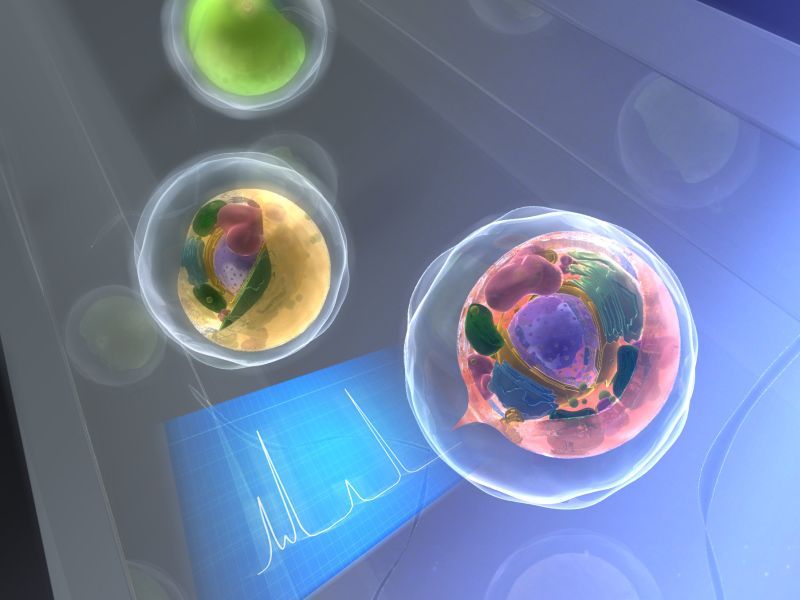Flow cytometry is a versatile tool that finds applications in various fields such as microbiology, immunology, virology, cancer biology, stem cell biology, and metabolic engineering. It can rapidly count and characterize large, heterogeneous populations of cells in suspension (e.g., blood cells, stem cells, cancer cells, and microorganisms) and dissociated solid tissues (e.g., lymph nodes, spleen, and solid tumors) with typical throughputs of 1,000-100,000 events per second. By measuring cell size, granularity, and the expression of cell surface and intracellular molecules, it provides valuable insights into biological processes. Some flow cytometers also have cell sorting capabilities that allow for further analysis of sorted samples (e.g., electron microscopy and DNA/RNA sequencing), cloning, and directed evolution.
However, traditional flow cytometry has certain limitations. It primarily relies on fluorescent labeling for cellular phenotyping, which is an indirect measure of intracellular molecules and surface antigens. Moreover, it often requires time-consuming preparation protocols and is not suitable for cell therapy.
To overcome these difficulties, a different type of flow cytometry based on direct measurements of intracellular molecules by Raman spectroscopy, or "Raman flow cytometry" for short, has emerged. Raman flow cytometry obtains a chemical fingerprint of the cell in a nondestructive manner, allowing for single-cell metabolic phenotyping. However, its slow signal acquisition due to the weak light–molecule interaction of spontaneous Raman scattering prevents the throughput necessary to interrogate large cell populations in reasonable time frames, resulting in throughputs of a few events per second.
Recently, we have provided a remedy to this throughput limit by integrating coherent Raman scattering methods such as stimulated Raman scattering (SRS) and coherent anti-Stokes Raman scattering (CARS) into flow cytometry. It offers a significantly enhanced light–sample interaction and hences enable high-throughput Raman flow cytometry, Raman imaging flow cytometry, and even Raman image-activated cell sorting (RIACS). Currently, we work on the further improvement of coherent Raman flow cytometry and the exploitation of new applications that have not been possible with conventional fluorescence-based flow cytometry or spontaneous Raman flow cytometry. Coherent Raman flow cytometry offers emerging opportunities in a wide range of fields from microbiology to cell therapy and cancer detection.
References
- M. Lindley, J. Gala de Pablo, W. Peterson, A. Isozaki, K. Hiramatsu, K. Goda, "High-throughput Raman-activated cell sorting in the fingerprint region", Advanced Materials Technologies 10, 2101567 (2022)
- J. Gala de Pablo, M. Lindley, K. Hiramatsu, and K. Goda, "High-throughput Raman flow cytometry and beyond", Accounts of Chemical Research 54, 2132 (2021)
- N. Nitta, T. Iino, A. Isozaki, M. Yamagishi, Y. Kitahama, S. Sakuma, Y. Suzuki, H. Tezuka, M. Oikawa, F. Arai, T. Asai, D. Deng, H. Fukuzawa, M. Hase, T. Hasunuma, T. Hayakawa, .., D. Di Carlo, Y. Hosokawa, S. Uemura, T. Sugimura, Y. Ozeki, and K. Goda, "Raman image-activated cell sorting", Nature Communications 11, 3452 (2020)
- K. Hiramatsu, K. Yamada, M. Lindley, K. Suzuki, and K. Goda, "Large-scale label-free single-cell analysis of paramylon in Euglena gracilis by high-throughput broadband Raman flow cytometry", Biomedical Optics Express 11, 1752 (2020)
- K. Hiramatsu, T. Ideguchi, Y. Yonamine, S. Lee, Y. Luo, K. Hashimoto, T. Ito, M. Hase, J. Park, Y. Kasai, S. Sakuma, T. Hayakawa, F. Arai, Y. Hoshino, and K. Goda, "High-throughput label-free molecular fingerprinting flow cytometry", Science Advances 5, eaau0241 (2019)
- Y. Suzuki, K. Kobayashi, Y. Wakisaka, D. Deng, Y. Fujiwaki, H. Liu, S. Tanaka, C.-J. Huang, C. Lei, S. Lee, A. Isozaki, .., T. Sugimura, N. Nitta, K. Goda, and Y. Ozeki, "Label-free chemical imaging flow cytometry by high-speed multicolor stimulated Raman scattering", PNAS 116, 15842 (2019)

Raman flow cytometry
- Field leader: Tianben Ding
- Funding: KISTEC, Nakatani Foundation, Ogasawara Foundation
- Collaboration: Serendipity Lab